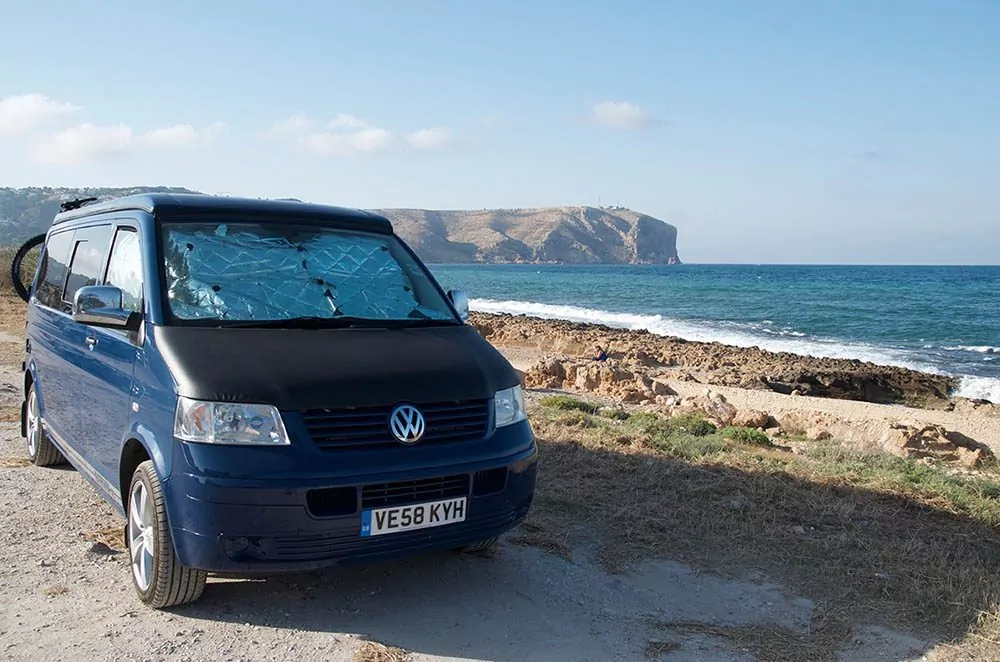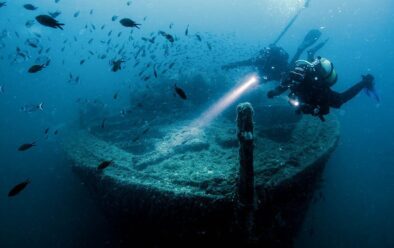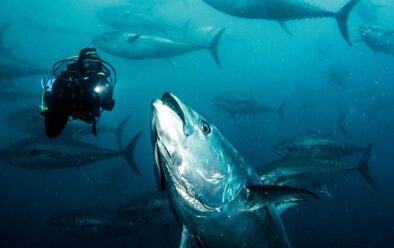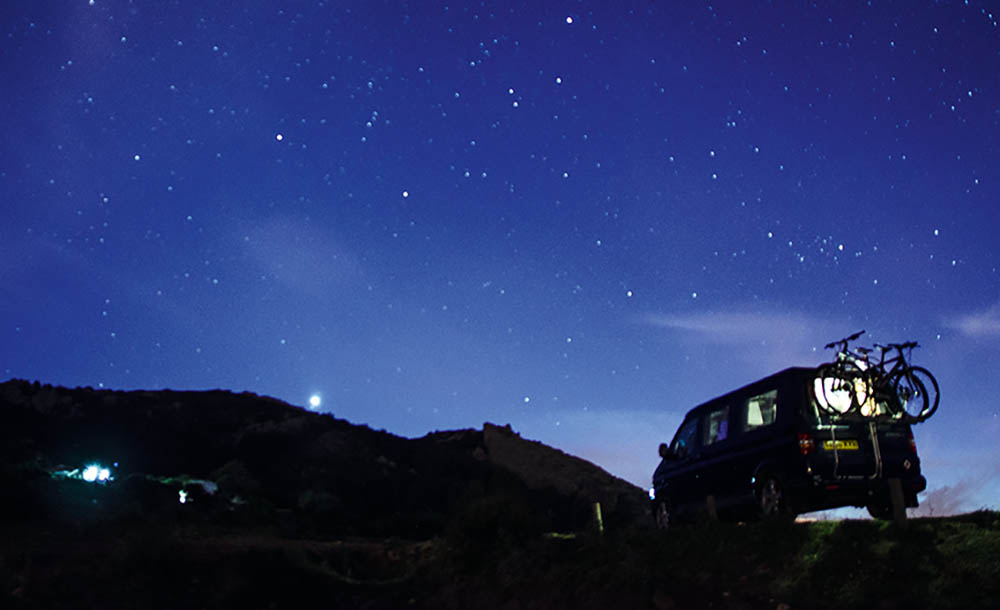SPAIN DIVER
VIAJE The Spanish Road Trip
Three weeks touring southern Spain in a mobile home, with a set of varied dives in prospect – let’s go, says WILL APPLEYARD, or should that be vamonos!?

Will & Ana’s VW Campervan at Javea.
#vanlife, #campervan, s #lifeontheroad; search any of these hashtags on social media and you find yourself pawing through a gazillion polished images depicting twee couples (with dog) living the dream in their beloved “rolling home” (a campervan).
My partner Ana and I thought it might be fun to embark on a Spanish-based “drive and dive” road trip in our own rolling home. Yet, having spent many months on the road over the past two years, we were under no illusion about the realities of #vanlife.
The freedom of this kind of travel affords a fantastic existence, but the associated Instagram photographs should come with hashtags such as #squabblingcouple, #toiletfacilities? and #i-wish-i-had-air-conditioning.
Previous van trips to the Spanish coast had taken us down the length of France, trying to avoid the toll-roads, but I can’t decide which is worse – endless back-road roundabouts (the French invented them) or stopping to pump euros into toll-booth machines after every few miles of, admittedly superb, motorway.
So we travelled with Brittany Ferries from Portsmouth to Santander in north-west Spain and skipped France completely.
The crossing takes 24 hours but saves wear, tear and mileage on the van and is awesomely relaxing (weather permitting).
The diving destinations had been pre-planned with help from the tourist offices of Murcia, Benidorm and Valencia.
Things started badly once landed – an awful night’s sleep somewhere four hours’ drive south of Santander in one of the most violent electrical storms I’ve seen.
Tired, I made a poor decision in parking under a tree in a lorry park. The tree was subsequently hit by lightning, with a deafeningly explosive sound.
Appeared in DIVER October 2018
we soldiered on south as the temperature rose, passing Salamanca, skirting Mérida and with a brief stop in Seville to see friends and stock up on food and water before swinging east for the seven-hour drive to Cabo de Palos, Murcia.
We prefer to “wild-camp” when and where we can rather than stopping in official campsites, so need to be self-sufficient with lots of water, solar panels, a 240V power-inverter and our (partly) home-made pressure shower.
Bars, cafés and dive-centres provide us with additional bathroom facilities.
There is always the chance of being moved on by the police when wild-camping in some countries, but if you’re reasonably covert and leave no traces it isn’t usually a problem.
I had been to Cabo de Palos before for diver when, because of a mix-up with the diving schedule, I missed out on its most-accessible wreck El Naranjito, so I was keen to add it to our three-week, 10-dive schedule.
In a campervan you can change the view as often as you like, and Cabo de Palos gave us fabulous views of the sea beside a little cove.
We arrived late and parked reasonably close to several other van-dwellers with the same idea – a good sign that it’s probably OK to stop for a night.
As the sun rose we headed to nearby Islas Hormigas dive centre. Ana donned a drysuit and I opted for my 6mm full-length suit, which I would later regret. Boil on the boat or freeze under water?

On the night of 13 April, 1943, the 51m Isla Gomera was bound for Barcelona from Cartagena. She started listing heavily to port in rough weather, took on water and shed her load of oranges, sinking with no loss of life. The Spanish word for orange is naranja, giving the site its pet name El Naranjito.
The wreck lies at 28m to the bow, 35m at the deck and bottoms out at 45m to the seabed, with a buoy-line attached to the bow. As we descended in average visibility, the temperature on my computer ticked down from 22° to a teeth-chattering 14° at 35m for me in my wetsuit.
Diving on a standard 21% mix, I also found myself wishing for nitrox as our no-deco time ticked away. The wreck is fabulously intact and we swam through the wheelhouse, over one of two cargo-holds and to amidships, leaving us just a few minutes to take everything in before heading back towards the buoy-line for classic diver/bow photos.
The available depths do cover a range of diving desires. Sunfish are said to visit the buoy-line regularly but only later in the trip would we would see one.
Cabo de Palos also boasts a staunchly protected marine reserve, full of life from grouper, to barracuda and clouds of smaller fish, and is a benchmark for Spanish marine reserves. Everybody to whom we spoke about diving during our trip was enthused by it.
The dry heat of Spain is a blessing when having to dry dive-gear, and by the time we were ready to move on to Benidorm everything was about dry.
It’s essential to keep equipment in dry bags too, should there be no time to dry kit. My wetsuit and boots take on an interesting aroma after repetitive diving.
Benidorm Island was another re-visit destination, but we wanted to dive it by day, rather than at night as I had done before, and with Nisos dive centre on this occasion.
Dive one of two started badly, however. A gushing surface current made descending the buoyline from RIB to reef very hard work, the visibility wasn’t what Nisos was expecting and once again I froze my… gloves off. I felt for dive-centre owners Jessie and Jose, devastated that their beloved go-to site wasn’t working as we moved on for dive two.
Now moored on the lee side of the island, with the towering hotels of Benidorm as a backdrop a nautical mile or two away, we dropped into fabulously clear warm water to 20m. Two octopuses sneaked into holes on the seabed, and almost immediately afterwards a pair of eagle rays flew past and off into the blue.
The sheer island walls resembled a pile of pancakes. We dropped 10m to the seabed and saw house slipper and spiny lobsters, nudibranchs and conger eels.
I felt happy that Jessie and Jose could now show off their doorstep.
Swim-throughs offer divers the chance to play here too. After exiting one, we saw five or six more eagle rays flap past in formation, vanishing but then returning for a second look. Jessie spent time with a sunfish (or pez luna in Spanish) while waiting for us to return to the boat.
We used an official campsite for two nights while diving at Benidorm – the city is no place to wild-camp if you can help it.
Spending two nights at a destination allows you to leave all your dive-kit with the dive-centre overnight and collect it dry before leaving the area.
we headed north further up the east coast and on to new territory for us – Javea, or Xabia in Catalan, in the region of Valencia. Unusually this part of Spain has quite a few toll-roads, though these are easily avoided. It’s hot in Spain in June and July, driving for several hours with no air-conditioning is wearing and as the heat rises, so do tempers!
Javea town sprawls around two main beaches, one rock, one sand. We parked beside the quieter rocky beach metres from the sea and enjoyed a Mediterranean view.Watching splendid sunrises from the comfort of your bed, with tea, is the only way to start a day.
Cabo la Nao dive-centre looked to be straight from a PADI catalogue. It was decked wall-to-wall with new rental gear, and had a plush reception within a newly decorated modern building, inside and outside kit-drying areas and plenty of staff. Scores of Spanish weekend divers milled about loading RIBs with gear for the morning’s dives. We fell into the mix.
Our RIB headed south, with the dive briefing taken care of before the skipper hit full steam and we sped towards towering orange cliffs.
Only some of the coastal area here is designated marine reserve, so it can be hit and miss for marine life. The rock formations below were inviting, though diving with a group of mixed-ability divers meant that we couldn’t explore as much as we would have liked.
A couple of cave-like swim-throughs added interest and it was good to see an abundance of posidonia, the seagrass so important to Mediterranean ecology. Our guide felt that the fishing grounds closely surrounding the marine reserve gave the fish no chance to flourish.
The diving was pleasant enough, vis average and a quick turnround at the dive-centre saw us back in the water for a second dip just before lunch.
Denia was only a seven-mile drive further north. We weren’t taken with this major port town, which services ferries to the Balearic Islands, but were blown away by our camping spot in Les Rotes, 10 minutes’ drive away.
Where the road finishes a gorgeous bay begins, and we parked by the beach and prepared our camera equipment for a morning dive with Marday’s dive-centre in Denia’s marina.
Marday’s was the only dive-boat on our trip that provided snacks and sweets between dives, and the only one that asked if we wanted to conduct our own dive away from the group.
The skipper tied into a fixed buoy-line, and we made for the seabed at 17m. With the vis back on our side, I positioned myself to photograph Ana with a pair of grouper beside an overhang arching off from a house-sized boulder.
But all I could see was black in the viewfinder – I had left the lens-cap on the camera. It glared at me as I turned the dome-port towards me. I showed Ana, who laughed bubbles at me as we continued the dive.
Big boulders, rock formations and swim-throughs feature in this dive-spot surrounded by rippling sand, enhancing the light streaming down from above.
We finned through a labyrinth of cracks, caves and tunnels but, as at Javea and the grouper apart, we were hardly surrounded by fish.
We were entertained, however, and looked forward to the second, lens-cap-free, dive. This occurred in an area often replete with sunfish, and we caught sight of one from the boat just before it left the surface on our way back to the marina.
The topography in this area is spectacular with its cliffs, coves and caves and we also enjoyed snorkelling here each evening before a campervan dinner, or early in the morning before breakfast.
We spent an extra night in Les Rotes, unable to tear ourselves away from this gem of a swimming and camping spot.
Then it was back on the road towards Alcossebre to dive one of the Med’s best-kept secrets, the Columbretes Islands.
It took two attempts to reach the islands, a two-hour dive-boat-ride from the mainland. On attempt one, the wind picked up just before we reached the main island, forcing us to turn back.
Next day we again loaded Barracuda dive-centre’s boat with equipment and food supplies for the day, and sought a comfortable spot aboard. We completed a bit of paperwork on our way because the marine park, declared a wildlife reserve since 1988 above and below the water, is strictly protected.
The islands came into view after an hour: four variously sized islets with the largest home to a 19th century lighthouse, park rangers and biologists.
We were to dive twice with one “photographer-sympathetic” dive-guide and a group of 10 paying divers. Ten is probably five too many for any led group, but general diving ability good.
the last time i immersed myself in such a rich variety and abundance of fish species was probably during my last Red Sea visit. Species from grouper
to bream to wrasse and schooling smaller fish filled every space, the view interrupted only by chilly thermoclines as we moved down to 25m.
We glided along vast walls plunging seemingly into nowhere and stretching high above us towards the surface in off-the-chart water clarity. Inviting chasms offered havens for lobster, and cleaning stations were in use around every bend.
One in five of the grouper seemed to be of the inquisitive kind, to the point where my camera became a shield.
Dome-ports attract many species, but I hadn’t previously considered grouper as vain. We explored two of the islets across our dives and yearned to see more.
We came across military ordnance from a time when weapons-testing went on here. These islands would lend themselves perfectly to liveaboard diving – a kind of Similan-come-Brothers Islands or even, dare I say, a mini-Galapagos on our European doorstep (though with fewer pelagics). Dive rules are strictly observed, and groups must finish their dive at the mooring-line from which they started.
A school of tuna raced past the stern as we hunkered down in shady spots for the boat-journey back.
We used the dive centre’s overnight drying “service” for the last time before heading to our final destination, L’Ametla de Mar.

A flash of yellow passed beneath me as I dipped my face into the water, then another. Seagulls sat in rows along the heavy plastic rim of the structure in which we floated as our dive-guide descended the steps of the boat to join us.
We were in the middle of a colossal, 15m-deep net, one of several, all closed at the bottom. Our next dive would be in the confines of a bluefin tuna farm.
Bluefin tuna are endangered in the wild, so such diving can be regarded as controversial. The arguments for and against fish farming go on, but Tuna Tours runs trips for scuba-divers and freedivers, its plush boat leaving from the fishing town of L’Ametla de Mar three times a day. We had found an ideal wild-camping spot just outside the town by a beautiful cove, shady pine trees providing welcome relief from the heat.
diving with several hundred monster tuna is not for everyone. They swim constantly around the net in a wide wall, perhaps 50 tuna across, at every depth. It was an exhilarating yet dizzying 40-minute dive and I constantly needed to move back to the wall for orientation.
Buoyancy skills go out of the window as the massed travelling fish create a vortex. I lost Ana almost immediately, and my vague photography plans went out of the porthole as I shot from the hip at the continuous flow of armour-plated creatures, almost mechanical in appearance and movement.
My posting on Facebook of a picture from this dive caused a ripple among diving friends who stand against farming of this species, though similar arguments could be used for the farming of any animal, and its effects on the environment.
Our Spanish road-trip had allowed us to venture deep into territory that might not have easily fitted into short holidays with plane-travel. We slipped back out of Spain and into France with more than 1000 miles now behind us.
And I can declare that this part of the Med is very much alive and kicking.
FACTFILE
GETTING THERE> Brittany Ferries from Portsmouth to Santander, brittany-ferries.co.uk.
DIVING> Cabo de Palos, Cartagena, islashormigas.com. Nisos, Benidorm, nisosbenidorm.es. Javea, cabolanao.com. Denia, mardaysresort.com. Alcossebre, Columbretes Islands, barracudabuceo.com. La Ametela de Mar, tuna dive, tuna-tour.com.
WHEN TO GO> Summer months.
MONEY> Euro.
HEALTH> Many Spanish dive-centres now ask to see a valid medical document.
PRICES> Ferry crossing £663 for two including cabin and campervan. Booking well ahead can mean big savings. Diving cost around 35 euros pp per dive, 60 euros for two. Columbretes day trip 120 euros, tuna dive 60 euros.
VISITOR Information> Murcia, murciaturistica.es. Benidorm, en.visitbenidorm.es, Valencia, en.comunitatvalenciana.com/diving. Will recommends the park4night app for finding free and paid international camping spots.

